BUFFALO CREEK #43
ALCO HH660
Updates 2012
| Its time for an update on the restoration of WNYRHS Buffalo Creek Locomotive. With the decent fall and winter weather we enjoyed in Western New York, work on #43 has progressed quite nicely. No decisions have been made on the type of batteries we will use. We would like to see if we can "jump start" the engine with the help of a Buffalo Southern locomotive before we commit to the big purchase. Late last summer we bought a pneumatic "needle scaler" to remove the thick grime and paint from the trucks from Harbor Freight and it works great! It is very efficient on the cast parts but also does well on sheet metal. Air consumption is very low and I highly recommend it for getting into nooks and crannys. |
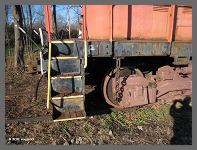 |
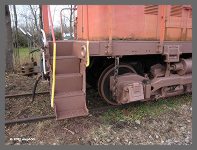 |
 |
 |
| Years of flaking paint were removed down to nice clean cast iron and sheet steel. All four steps, frame, battery side covers, air tanks and piping have been scaled, wire brushed and primed. The effort and results speak for themselves. We hope the "winter" weather continues to be mild to aid our progress. |
May 2012
| removing the hand rail the old deck was removed. The 1/2" frame plate was needle scaled and ground down to clean steel and primed. Urethane black enamel finished the job and the new deck received the same treatment. We used a plasma cutter to cut the new deck to size and cut the bolt slots which was much faster and cleaner than using a cutting torch! Before dropping the new deck in place a liberal coating of bearing grease was applied to the entire deck to help prevent future damage. |
| With the doors on the ground, we were able to use a 10 ton hydraulic jack and cribbing to remove the bends and take the twist out of number 4. After some grinding, wire brushing and priming, the doors went back on with ease and look great! On May 24th, we put 270 gallons of water into the cooling system and were happy to find we had no leaks! Next up, pressure oiling the engine and turning the prime mover over. |
July 2012
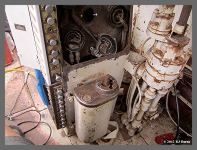 |
Rick B. has been working on the Control Stand system switches and brake controls. There was two layers of gray and one layer of black paint before getting down to the original ALCO green. |  |
| The control stand dash panel has been repainted and lettered. All six of the 4" brass guage face bezels have been bead blasted, new glass installed and then sealed with clear lacquer. Bob M. has done a wonderful job restoring the gauge faces and pointers. We can not wait to see the whole stand back together after all the flaking paint is removed! |
September 2012
| Over the hot days of summer we finished scaling, grinding and sanding all of the rust spots and getting them primed. Pat and Brian from the Buffalo Southern Railroad were amused to see primer "creeping" up all over the engine as they passed by each week. After all the grinding and sanding, the locomotive needed a good scrubbing! Society friend Gary S. was happy to allow us the use of his 3800psi Northern Hydraulic pressure washer. You really had to "brace" yourself when you pulled the trigger on that beast! |
| Once the letters were ready, we applied them to the engine counting rivets to get them in the exact same spot as shown in the photo. This process took us almost one whole day in itself. |
| It was quite a site to step back and see the engine as it last looked in 1966 when the Buffalo Creek sold the engine to RELCO. (Railroad Equipment Leasing Corporation) |
December 2012
| Another detail we attended to was the application of the FRA required letter "F" on both sides of the front of the locomotive. Below are the before and after views of the "F" and a look at FRA rule "229.11 - Locomotive identification." |
 |
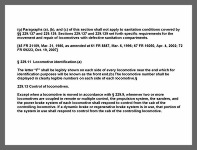 |
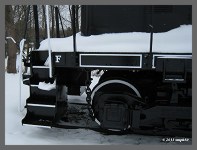 |
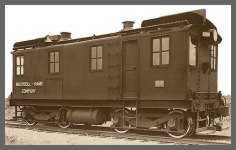 |
When the very first "Oil-Electric" later "Diesel-Electric" locomotives were built, the "Boxcab" design gave no indication as to where the engineer was located. In the early 20's, a letter "F" or "1" was used to identify the front of the | 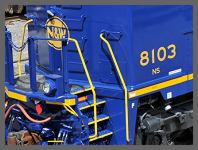 |
| locomotive. As locomotive design evolved, a distinct "cab" allowed for better visibility by narrowing the engine compartment or "hood." However, the "front" of the locomotive was kept in front of the prime mover with the engineer on the right hand side. It was not until 1934 that ALCO moved the "F" to the "hood end" of the locomotive. Todays modern GE and EMD locomotives still sport a small "F" at the "short hood" cab end. |
 |
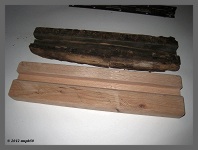 |
 |
| The WNYRHS greatly appreiciates all the generous donations to this project to date. However, we could still use your help! All Donations to the WNYRHS, Inc. are Tax-Deductable! If you would like to mail in a donation, send it to WNYRHS Inc., PO Box 416, Buffalo, New York 14231-0416 or |
| Click the PayPal Button to make a Secure Electronic Donation. THANK YOU! |
Web Site Hosting by TRAIN WEB
The WNYRHS, Inc. P.O. Box 416, Buffalo, NY. 14231-0416 is an independent organization and has no affiliation with any other local or national group.
The Society is a fully qualified organization under 501 (C) (3) of the Internal Revenue Code and all donations to the Society are tax deductible.
©Copyright 1999 , WNYRHS Inc. all rights reserved